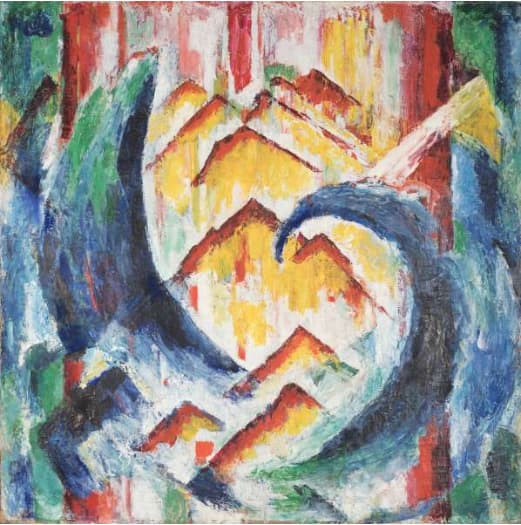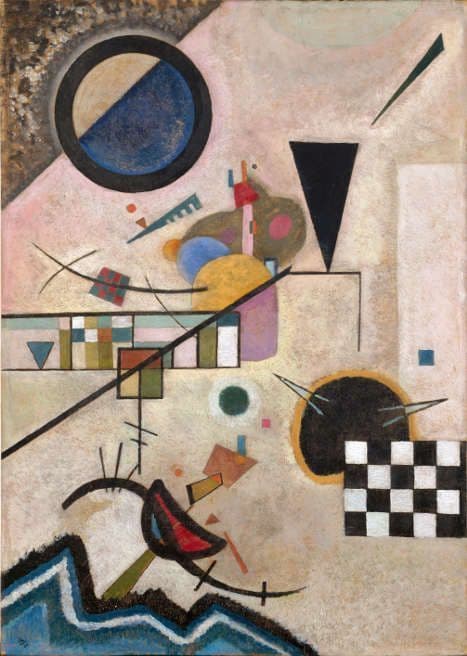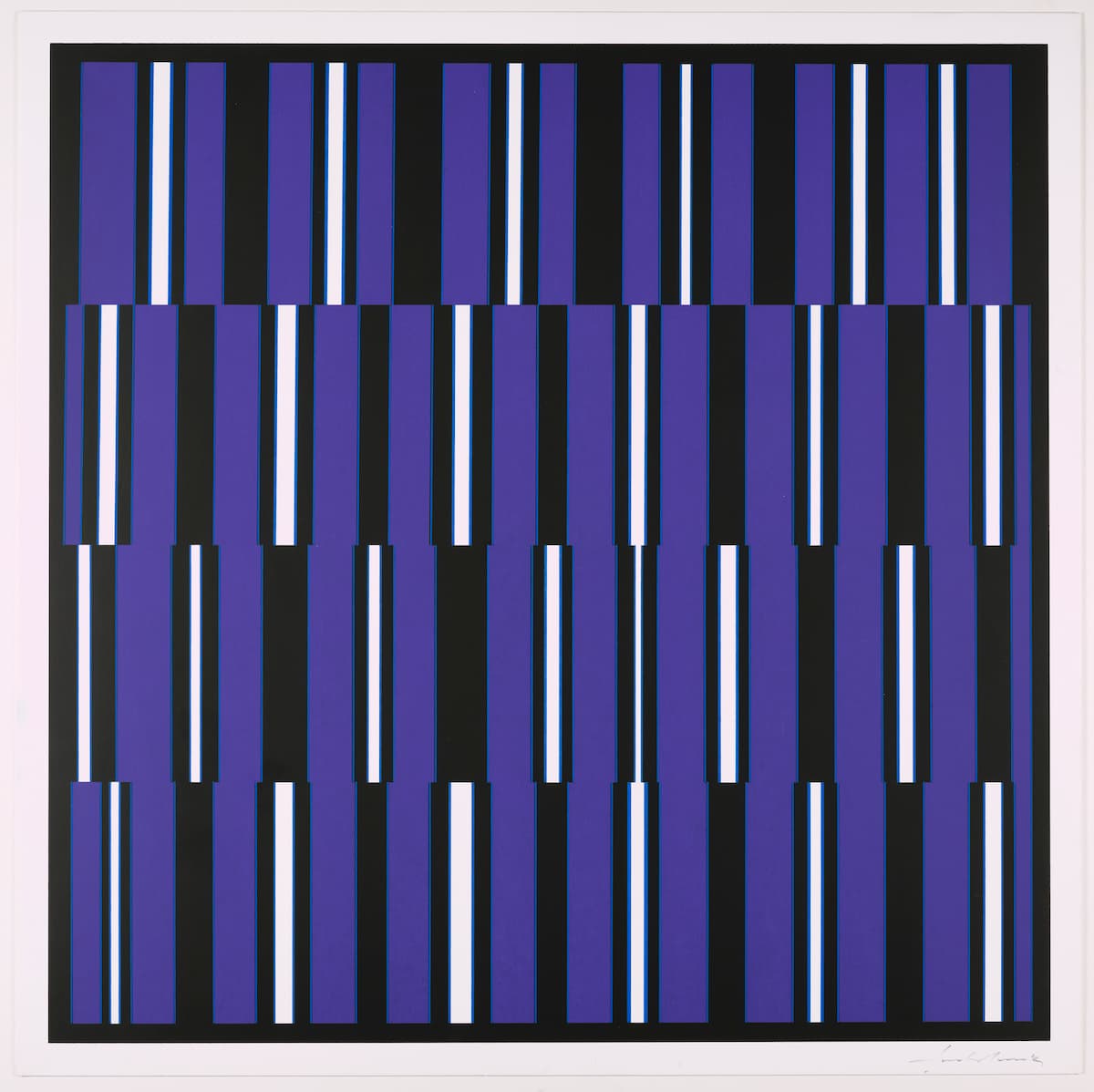Alfons Karl Zwicker: Vom Klang der Bilder
In his cycle for large orchestra and solo piano, Of the Sound of Pictures (Von Klang der Bilder), the Swiss composer, pianist, and painter Alfons Karl Zwicker (b. 1952) chose 5 modern artists: Erich Bucholz, Paul Klee, Wassily Kandinsky, Yves Klein and Günter Fruhtrunk and used indicative works of theirs to create his musical sound world. All the paintings are abstract, and all are from the 20th century.
Kandinsky, Klee, and others often captured musical elements in their paintings and Zwicker was attempting to bring these images back to music. First, he associated each picture with a specific set of words and ideas:
Erich Buchholz’s Song of Blood he connects with ‘destruction, farewells, tears, sadness, lamentation’; with Paul Klee’s Chorale and Landscape, ‘hope, confidence, humility, faith, nature’, with Kandinsky’s Countersign ‘a new polarisation of energies, existence of contradictions’, with Yves Klein’s Monochrome Blue ‘Movement in stasis, pausing, meditation, illusion, paradise on earth’, and with Fruhtrunk’s Pedal Point ‘Painful return of the identical in the Other’ and ‘Being different’.
The work is organized across the cycle by these definitions: ‘1. Virtuosic power of sound; 2. Peace in the manner of a Chorale; 3. Extreme contrasts; 4. Static meditation; 5. Finale in repetition.
When he began this work, he started with 16 images and eventually chose his final 5. The final choice was made easier by his belief that these images all ‘pointed at the same musical forces, namely a large, colourful orchestra with solo piano’.
The first work, Blutgesang by Erich Bucholz (1891–1972), was initially shown in a solo show in Berlin in 1921 as the first painting in the show. Buchholz had completed the work in 1920, following his painting hiatus after WWI. There are links to Der Blaue Reiter school of expressionism. The staggered yellow triangles give an impression of mountains, while the blue and green on the right and left form two encircling warm elements.

Erich Bucholz: Blutegesang, 1912 (Staatliche Museeun Perussicher Kulturbesitz National Galerie Berlin)
Alfons Karl Zwicker: Vom Klang der Bilder – I. Blutgesang (Peter Waters, piano; Bohuslav Martinů Philharmonic Orchestra; Monica Buckland Hofstetter, cond.)
Paul Klee, Choral und Landschaft was painted in 1921 and is in a private collection in Switzerland. Zwicker’s view of this as having the elements of ‘hope, confidence, humility, faith, nature’ come through in the orderly paths, the regularized houses, and the trees that spring up all through the painting: small trees, large trees, or just hints of trees on the right side.
In his music, Zwicker goes to a quieter mode, with the percussion stilled to occasional beats and the piano and orchestra at a minimal level. The previously solo piano becomes part of the orchestra, and the four colours of the painting (red, ochre, brown, and black) are transformed into orchestra colours. The Chorale of the title first emerges in the winds and then gains in importance as the movement continues. The string section splits into 26 individual parts that play in quarter tones, shadowing the strong mountain scene.

Paul Klee: Choral und Landschaft, 1921 (Bern: Sammlung Maja Allenbach)
Alfons Karl Zwicker: Vom Klang der Bilder – II. Choral und landschaft (Peter Waters, piano; Bohuslav Martinů Philharmonic Orchestra; Monica Buckland Hofstetter, cond.)
Wassily Kandinsky’s Gegenklänge from 1924 occupies the center of the musical work. Just as the images in the picture change abruptly from sea to land to mountain, from action to stillness, Zwicker’s movement contrasts virtuoso percussive sections with lyrical cantabile sections, with strongly contrasting dynamics to emphasize the change. The piano part reflects these abrupt changes, going from sweetly melodic to syncopated hammering chords. By the end of the work, the string section is now split into 40 individual lines.

Wassily Kandinsky: Gegenklänge, 1924 (Paris : Musée National d’art moderne, Centre Pompidou)
Alfons Karl Zwicker: Vom Klang der Bilder – III. Gegenklänge (Peter Waters, piano; Bohuslav Martinů Philharmonic Orchestra; Monica Buckland Hofstetter, cond.)
Yves Klein’s Monochrome Blue, from 1956, was created using a colour that Klein would later patent, known as ‘International Klein Blue’. The owner of this painting, the Staatsgalerie Stuttgart says about it, ‘Thanks to a special binder system, Klein preserves the graininess of the pigment, which he applies to the image support with a roller. This gives it a dull, lively, structured colour surface and creates the impression of indefinable spatiality, of blue depth. For Klein, blue as the colour of the incorporeal and spiritual is also a sign of the true, namely spiritual world, freed from material manifestations, of a space of freedom’.
Klein himself created an orchestral work based on his painting – a work for a large orchestra made up of a single note, ‘d’. Knowing this, Zwicker bases his movement around the same pitch, here given in the horn. The ‘d’ runs through the entire work, while the rest of the orchestra provides a shimmer based on a 6-note chord. The piano and the harp have repeating lines, and Zwicker’s idea is to have something that repeats but becomes more subtle each time.

Yves Klein: Monochrome bleu (IKB 219) (Staatsgalerie Stuttgart)
Alfons Karl Zwicker: Vom Klang der Bilder – IV. Monochromes blau (Peter Waters, piano; Bohuslav Martinů Philharmonic Orchestra; Monica Buckland Hofstetter, cond.)
The final work, Orgelpunkt by Günter Fruhtrunk, dates from 1965 and is not a painting but a colour silkscreen on light cardboard. There are copies all over the world that were published in 1967 as part of his publication, Six Serigraphs.
In his music, Zwicker uses the divisions of the artwork to create his own internal divisions of four sections of equal bar length but unequal time length because of their individual setups of tempo and rhythm. Beginning with a pretentious bell stroke, the atmosphere is at once tormented. The strings are divided now into 34 individual lines, and it’s the lower brass that drives the music forward. The ending is mysterious and dies away slowly, with vibraphone, cymbals, and tubular bells bringing it all to a quiet close.

Günter Fruhtrunk: Six Serigraphs: Orgelpunkt, 1967
Alfons Karl Zwicker: Vom Klang der Bilder – V. Orgelpunkt (Peter Waters, piano; Bohuslav Martinů Philharmonic Orchestra; Monica Buckland Hofstetter, cond.)
Zwicker’s project was immense, resulting in this 75-minute cycle for piano and orchestra. The decision to return art with musical references to a musical base is interesting and, in this case, gives a personal view of public art.
For more of the best in classical music, sign up for our E-Newsletter
